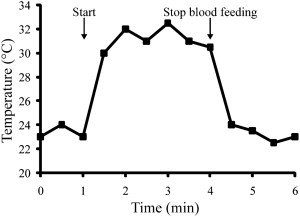One of my committee members is an insect physiologist. I picked him for my committee because he’s an excellent physiologist who has experience with lipid chemistry. (He’s also an all around nice guy and a very successful scientist.) I took a photoperiodism seminar that he taught, and it was my favorite seminar class in graduate school. Despite all of this, my understanding of insect physiology is… almost nonexistent. I know a little bit about diapause from his seminar and a writing class that I took with one of his advisees, but that’s about it. I’d like to learn, and if I had another year or two of grad school ahead of me I’d probably take an insect physiology class. As a wise man once said, “If ‘if’s and ‘but’s were candies and nuts then we’d all have a Merry Christmas,” am I right?
Anyway, my point is that he has a paper in PNAS this week that I found really interesting, but you’ll have to forgive me if there are any physiological inaccuracies in this post. I claim responsibility for anything that’s wrong.

Aedes aegypti. Credit: Flickr user Sanofi Pasteur
It may not seem like it during this part of the year (in the northern hemisphere anyway), but most of the time, mosquitoes don’t drink blood. Males and females both drink nectar for their own survival; it is the propagation of the species that requires your blood. Female mosquitoes sometimes need to take a hot blood meal to get the required proteins and iron for making eggs. While necessary for reproduction, drinking mammalian blood has a lot of unique physiological challenges, not the least of which is the temperature difference.
 At room temperature, the average human’s body temperature is about 15°C (almost 30°F) warmer than that of the average mosquito, and when a female takes a blood meal, her body temperature spikes 10°C in one minute! While ectotherms like mosquitoes are used to fluctuating body temperatures based on environmental conditions (such as the day/night cycle), these changes are usually gradual, allowing the mosquito ample time to alter their physiology. Hot blood meals impose the unique physiological problem of rapidly increasing body temperature without much time to adjust, which can cause enzymatic dysfunction and disrupt physiological pathways such as digestion, reproduction, and metabolism.
At room temperature, the average human’s body temperature is about 15°C (almost 30°F) warmer than that of the average mosquito, and when a female takes a blood meal, her body temperature spikes 10°C in one minute! While ectotherms like mosquitoes are used to fluctuating body temperatures based on environmental conditions (such as the day/night cycle), these changes are usually gradual, allowing the mosquito ample time to alter their physiology. Hot blood meals impose the unique physiological problem of rapidly increasing body temperature without much time to adjust, which can cause enzymatic dysfunction and disrupt physiological pathways such as digestion, reproduction, and metabolism.
Obviously mosquitoes are not dying out because they are heat stressed and can’t reproduce (wouldn’t that be great?), so how are they getting around this problem? Heat shock proteins! Heat shock proteins can aid as enzymatic “chaperones”, making sure that the enzyme proteins stay folded in the proper conformation during times of physiological stress (not just heat but also extreme cold, lack of oxygen, infection, or exposure to toxins, among other things). Enzymes are a key player in digestion; they aid in the breakdown of proteins, fats, and carbohydrates, and the absorption of certain nutrients, so the mosquitoes definitely want to conserve their function right after taking a meal.
 It turns out that female mosquitoes experience an 8-fold spike in heat shock protein expression in the midgut following a hot blood meal. When the mosquitoes were prevented from being able to express HSP70 (the heat shock protein active in these mosquitoes), the blood proteins from their meal stayed in the midgut longer, suggesting that digestion of blood proteins is somehow impaired. It is unclear whether this is due to a deficiency in breaking down the proteins or slower uptake of proteins and nutrients from the midgut, but the result is the same: the proteins are staying in the midgut longer instead of going into the body and aiding egg formation.
It turns out that female mosquitoes experience an 8-fold spike in heat shock protein expression in the midgut following a hot blood meal. When the mosquitoes were prevented from being able to express HSP70 (the heat shock protein active in these mosquitoes), the blood proteins from their meal stayed in the midgut longer, suggesting that digestion of blood proteins is somehow impaired. It is unclear whether this is due to a deficiency in breaking down the proteins or slower uptake of proteins and nutrients from the midgut, but the result is the same: the proteins are staying in the midgut longer instead of going into the body and aiding egg formation.
While heat shock proteins are not preferentially expressed in the ovaries after a hot blood meal, the mosquitoes prevented from expressing HSP70 also made fewer eggs than control mosquitoes, which provides further evidence that the delay of protein digestion and nutrient absorption is interfering with egg production. Since mosquitoes are vectors for many human diseases, research like this can be used towards initiatives to potentially limit the fecundity of mosquitoes (i.e. how rapidly they reproduce) and reduce human infection with diseases like yellow fever, malaria, and dengue fever.
 Benoit, J., Lopez-Martinez, G., Patrick, K., Phillips, Z., Krause, T., & Denlinger, D. (2011). Drinking a hot blood meal elicits a protective heat shock response in mosquitoes Proceedings of the National Academy of Sciences DOI: 10.1073/pnas.1105195108
Benoit, J., Lopez-Martinez, G., Patrick, K., Phillips, Z., Krause, T., & Denlinger, D. (2011). Drinking a hot blood meal elicits a protective heat shock response in mosquitoes Proceedings of the National Academy of Sciences DOI: 10.1073/pnas.1105195108
To comment on this post, please go here.
















